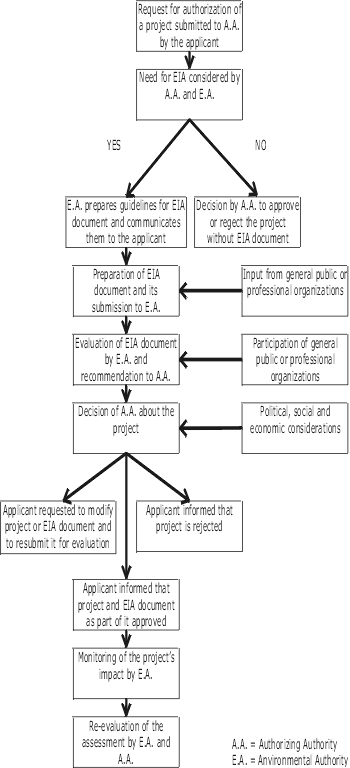Evaluation and Assessment Techniques
These techniques are an aid in analysing the effect proposed
measures (alternative developments) have on aspects of
the coastal system. Well established techniques exist
for the following aspects:
- quality of the natural environment
- risk for natural disasters
- economical efficiency
Quality of the natural environment
Techniques analysing effects with the focus on the
quality of the natural environment are usually called:
"environmental impact assessment" (EIA) techniques.
Currently, the use of EIA is legislated
in the EU since 1985. In that year, the EU enforced
the EIA Directive on Environmental Impact Assessment
for projects. In 2000 a similar Directive (Strategic
Environmental Assessment, SIA) was adopted for plans,
policies and programmes. These assessments ensure that
significant environmental impacts are identified and
assessed and taken into account in the decision making
process to which the public can participate. The EU
published three guidelines, corresponding to three stages
of environmental assessments:
- Screening: The process by which a decision is taken
on whether or not EIA is required for a particular
project.
- Scoping: The process of identifying the content
and extent of the environmental information to be
submitted to the EIA authority.
- Review: The process of establishing whether an
EIS is adequate for the EIA authority to use it to
inform the decision makers.
The UNEP published a useful report about how to to
EIA in marine and coastal zones (Figure SCHEME, UNEP90).
EA techniques exist for specific themes: the Carrying
Capacity Assessment (CCA), Climate Impact Studies (CIS),
Rapid Assessment of Coastal Communities (RACE).
|
Example: simplified flow chart for the EIA procedure
The flow chart shows how an EIA procedure could be implemented
following UNEP90.
It is based on a set of 13 guiding principles which define
what an EIA should include which were endorsed by the
General Assembly of the United Nations in 1987 (click
for a larger version):

|
|
Risk for natural disasters
Increasing developments in coastal zones lead to the
fact that people, their properties, and the flora and
fauna are exposed to increasing risks and vulnerability
for natural disasters like flooding, landslides and
tanker accidents. In the Mediterranean Basin, earthquakes
are a major coastal risk. In many tropical regions,
flooding caused by rivers or the sea is a major
problem. To reduce the risk for and impact of natural
disasters, these risks must be assessed and managed.
The standard Environmental Risk Management strategy
will:
- Identify what can go wrong and prioritize the most serious
hazards;
- Consider how likely such events are to happen, how tolerable
it will be if each does and how each might be avoided,
reduced or controlled;
- Implement the most appropriate policy option;
- Evaluate the effectiveness of the chosen risk mitigation.
A risk assessment should be standard part of the evaluation
of ICZM projects. Read more on Environmental Risk Assessment
(ERA) in the CoastLearn module.
|
|
Economical efficiency
Many decisions are taken if the benefits are proven. Thus, it is logical to include studies in the evaluation
of ICZM programmes who determine the economical efficiency
of a proposal. A common difficulty in applying economical
techniques to evaluate investments with nature values
involved, is that the latter are difficult to express
in terms of money. In addition, the relevant aspects
of the coastal system are not always understood completely,
and one easily neglects negative or positive effects
(costs or benefits) one activity has on another. Examples of techniques are:
- cost/benefit analysis (CBA): An analysis in which
the discounted benefits and costs are compared. The
benefits of a development should exceed the costs
before a go-ahead is given;
- least cost analysis: A least cost analysis does
not consider the benefits, either because they can
not be determined, or when there are no significant
different benefits among the alternatives. In this
case, the decision is based on the discounted costs
which should be as low as possible, of course.
|